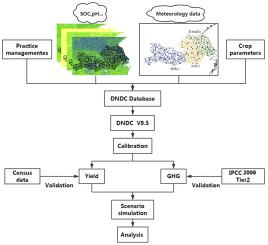Agricultural Systems ( IF 6.6 ) Pub Date : 2021-02-09 , DOI: 10.1016/j.agsy.2021.103087 Yifan Shi , Yunsheng Lou , Yiwei Zhang , Zufei Xu

|
Context
With the growing demand for food and the threat from climate change, increasing grain yields with lower greenhouse gas (GHG) emissions is an important target. Yet, the quantitative effects of climate change and management practices on yield and global warming potential (GWP) of rice-winter wheat rotations are still uncertain.
Objective
To investigate the key factors influencing the tradeoffs between yield and GHG of rice-winter wheat ecosystems in mid-eastern China over the two periods.
Methods
In this study, the DeNitrification-DeComposition (DNDC) model was used to examine the spatio-temporal county-scale variations in yields of rice-winter wheat rotations and associated GHG (CH4, N2O) and GHG intensity (GHGI) over two periods (1980–1989, 2010–2019) in mid-eastern China. The DNDC model is driven by a county-scale database, consisting of meteorological data (79 stations), soil properties, management practice, and crop parameters for 213 counties. Eight scenarios were defined to isolate the individual and combined impacts of climate change, new cultivars adoption, and management practices on yields, GWP, and GHGI.
Results and conclusions
Results revealed that the total yield increased by 48.7% over the two periods but stagnated in the 2010s; the average emission rate of CH4 and N2O in the two periods were 250.7, 196, 0.63 and 2.83 kg ha−1, respectively, while GWP and GHGI declined by 12.8% and 38.3%. The individual contributions of climate change, new cultivars adoption, and management practices to the GHGI of the rice-winter wheat rotations were 37%, −42.5%, and 16.4%, respectively. Adoption of new cultivars was a decisive factor for improving yields and mitigating GHG, while climate change and management practices had a minor influence on yields. The negative responses of yield to improved management practices (i.e., high N fertilization, mid-season drainage) were mainly attributed to soil organic carbon (SOC) and bulk density variations and different fertilization patterns. The combination of new cultivars adoption and management practices decreased GHGI by 46.6%. These findings demonstrate the importance of high-yield crop varieties to low carbon agriculture, and that management practices should be adapted to local conditions and specific crop varieties.
Significance
Given that the crop harvest index is approaching its theoretical upper limit and that promoting new varieties presents many challenges, future innovations should focus on introducing optimal strategies that balance the tradeoffs between yield and GHG emissions to mitigate the negative effects of climate change on agriculture.



























 京公网安备 11010802027423号
京公网安备 11010802027423号